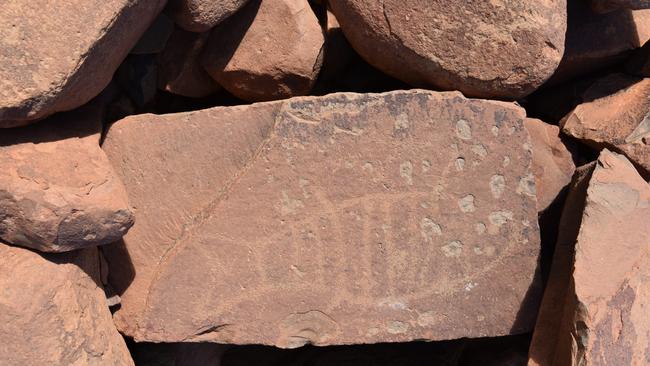Emissions take the gloss off ancient rock art
Researchers say that industrial emissions on Western Australia’s Burrup peninsula have damaged some of the area’s ancient Aboriginal rock art.

A new study has delivered what researchers say is the first visual proof that industrial emissions on Western Australia’s Burrup peninsula have damaged some of the area’s ancient Aboriginal rock art.
With the federal government investigating the environmental and cultural impacts of billions of dollars of planned investment in the area, including major projects being advanced by Woodside Energy and private company Perdaman, new research led by University of Western Australia archaeologist Benjamin Smith documented what he said was visual evidence of petroglyphs being damaged by acidic emissions from nearby heavy industry.
The Burrup peninsula, in WA’s northwest coast, is home to more than one million petroglyphs dating back tens of thousands of years. It is also home to some of Australia’s largest and most valuable export projects, with major developments such as Woodside’s North West Shelf and Pluto liquefied natural gas plants and Yara International’s Pilbara fertiliser plant having been built in the area since it was identified as a site for heavy industry in the 1960s.
The potential impact on the rock art from the LNG and fertiliser plant emissions has been the subject of ongoing debate, but Professor Smith said his study – which involved comparing historical photos of 26 pieces of rock art from the 1960s and 70s with contemporary photographs – showed signs of damage to about half the petroglyphs analysed. He said the study found numerous examples of rock art that was now lighter in colour than it was in years before industrialisation, a clear indication chemicals were eroding the outer layer of the rocks. Almost all of the changed petroglyphs were relatively close to industry.
“This is direct evidence of industrial emissions damaging the rock art,” Professor Smith told The Weekend Australian.

“In the area around Woodside we are seeing a lot of those rocks changing colour. That means that the acid and other things coming out of those stacks at Woodside and Yara are causing a visual impact on the rock. The rock is actually breaking down.”
One of the most visibly damaged petroglyphs was an engraving of a fish. It has experienced extensive flaking. That petroglyph, and numerous others nearby, sat near a road previously used for the hauling of salt to a port.
The damage appeared to have resulted from salt being blown on to the rocks, although Professor Smith noted that the rate of damage appeared to have slowed dramatically after the trucks were replaced by a conveyor belt in the early 2000s.
The findings come at a particularly sensitive time for the Burrup. There are ongoing campaigns from Indigenous and environmental groups against Perdaman’s proposed $6.5bn urea plant, Woodside’s plans to extend the life of its North West Shelf plant out to 2070, and Woodside’s development of the Scarborough gas field through a doubling of its Pluto LNG facility.
At the same time, a government-backed application for the area to be given a UNESCO World Heritage listing is continuing. Environment Minister Tanya Plibersek earlier this year rejected an application for a temporary halt over Perdaman’s urea plant, but did approve the appointment of an independent reporter to investigate the broader impacts and risks to the Burrup’s rock art.
A spokeswoman for Woodside said the company was reviewing Professor Smith’s findings, but noted that historic monitoring of colour changes had provided inconclusive results.
“The impacts suggested to align with industrial emissions are based on apparent changes in colour, though as the article notes throughout, the photographic methodology used is not a reliable means of determining such changes,” the spokeswoman said.




To join the conversation, please log in. Don't have an account? Register
Join the conversation, you are commenting as Logout